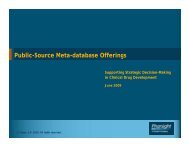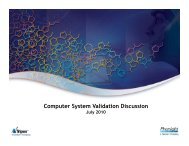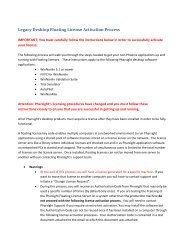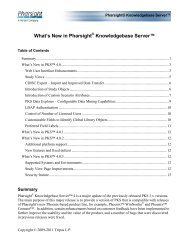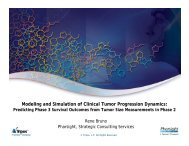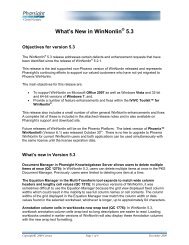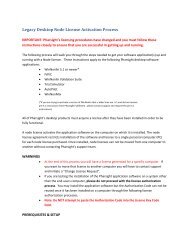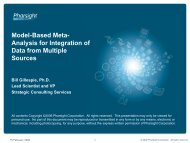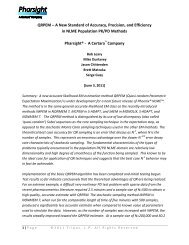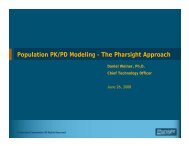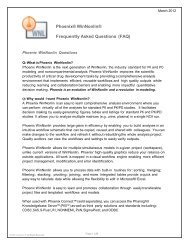Role of PKPD Modeling and Simulation in Influencing ... - Pharsight
Role of PKPD Modeling and Simulation in Influencing ... - Pharsight
Role of PKPD Modeling and Simulation in Influencing ... - Pharsight
You also want an ePaper? Increase the reach of your titles
YUMPU automatically turns print PDFs into web optimized ePapers that Google loves.
<strong>Role</strong> <strong>of</strong> <strong>PKPD</strong> <strong>Model<strong>in</strong>g</strong> <strong>and</strong> <strong>Simulation</strong> <strong>in</strong> Influenc<strong>in</strong>g the<br />
Design <strong>of</strong> Early Cl<strong>in</strong>ical Studies<br />
June 8 th 2011, Zurich, Switzerl<strong>and</strong><br />
Henri Merdjan, Pharm, AIHP<br />
Senior Director, <strong>Pharsight</strong> Consult<strong>in</strong>g Services Europe<br />
henri.merdjan@certara.com
Outl<strong>in</strong>e<br />
• A Brief History <strong>of</strong> PK/PD <strong>and</strong> <strong>of</strong> its Environment<br />
• <strong>Role</strong> <strong>of</strong> PK/PD <strong>Model<strong>in</strong>g</strong> <strong>and</strong> <strong>Simulation</strong> <strong>in</strong> Influenc<strong>in</strong>g<br />
the Design <strong>of</strong> Early Cl<strong>in</strong>ical Studies<br />
• Case Study 1:<br />
• Case Study 2:<br />
transition<strong>in</strong>g from precl<strong>in</strong>ical to FIH<br />
assessment <strong>of</strong> an <strong>in</strong>-licens<strong>in</strong>g c<strong>and</strong>idate<br />
• Future perspectives <strong>of</strong> PK/PD <strong>Model<strong>in</strong>g</strong> <strong>and</strong> <strong>Simulation</strong><br />
Slide 2<br />
© Tripos, L.P. 2011 All Rights Reserved
A Brief History <strong>of</strong> PK/PD<br />
THE LATE 60’S:<br />
A PREMATURE BIRTH?<br />
Slide 3<br />
© Tripos, L.P. 2011 All Rights Reserved
1968: The Birth <strong>of</strong> PK/PD<br />
• Presence <strong>of</strong> a delay between norep<strong>in</strong>ephr<strong>in</strong>e<br />
concentration-time pr<strong>of</strong>iles <strong>and</strong> the k<strong>in</strong>etics <strong>of</strong><br />
pharmacological response, i.e. blood pressure-time<br />
data.<br />
• G<strong>in</strong>o Segre <strong>in</strong>troduced the concept <strong>of</strong> a ―hypothetical<br />
effect compartment‖ to account for this delay.<br />
• This allowed an empirical description <strong>of</strong> timedissociated<br />
k<strong>in</strong>etics.<br />
Segre G. K<strong>in</strong>etics <strong>of</strong> <strong>in</strong>teraction between drugs <strong>and</strong> biological systems. Farmaco Sci. 1968<br />
Oct;23(10):907-18.<br />
Slide 4<br />
© Tripos, L.P. 2011 All Rights Reserved
1968: Was it a Premature Birth?<br />
• NONLIN s<strong>of</strong>tware only <strong>in</strong>troduced <strong>in</strong> a year later by Carl<br />
Metzler.<br />
• It was written <strong>in</strong> FORTRAN-66 programm<strong>in</strong>g language for<br />
ma<strong>in</strong>frame computers.<br />
• Long gap <strong>of</strong> PK/PD publications until 1979<br />
CM Metzler. A Users Manual for NONLIN. Technical Report 7297 69 7292 005. Upjohn Co.,<br />
Kalamazoo, Michigan (1969).<br />
Slide 5<br />
© Tripos, L.P. 2011 All Rights Reserved
A Brief History <strong>of</strong> PK/PD<br />
THE LATE 70’S:<br />
A REBIRTH<br />
Slide 6<br />
© Tripos, L.P. 2011 All Rights Reserved
1979: A Rebirth<br />
Lewis She<strong>in</strong>er <strong>and</strong> coworkers made Segre’s model more popular. They<br />
were the first to formalize this concept <strong>in</strong>to a model to describe<br />
hysteresis caused by distribution to the biophase.<br />
It was reborn as the ―L<strong>in</strong>k Model‖:<br />
Cp<br />
Effect<br />
Effect<br />
HYSTERESIS LOOP<br />
Time<br />
Time<br />
Cp<br />
Ce<br />
EQUILIBRIUM KINETICS<br />
Effect<br />
Effect<br />
DIRECT RELATIONSHIP<br />
Time<br />
Time<br />
Ce<br />
She<strong>in</strong>er LB, Stanski DR, Vozeh S, Miller RD, Ham J. Simultaneous model<strong>in</strong>g <strong>of</strong> pharmacok<strong>in</strong>etics <strong>and</strong> pharmacodynamics:<br />
application to d-tubocurar<strong>in</strong>e. Cl<strong>in</strong> Pharmacol Ther. 1979 Mar;25(3):358-71.<br />
Slide 7<br />
© Tripos, L.P. 2011 All Rights Reserved
―Les premiers pas‖ by Jean-Pierre Augier<br />
A Brief History <strong>of</strong> PK/PD<br />
THE 80’S:<br />
TODDLING<br />
Slide 8<br />
© Tripos, L.P. 2011 All Rights Reserved
80’s: Toddl<strong>in</strong>g<br />
Grow<strong>in</strong>g use <strong>of</strong> PK/PD model<strong>in</strong>g, with applications to<br />
diverse therapeutic areas (ma<strong>in</strong>ly cardiovascular)<br />
Source: Pubmed search on March 29 th , 2011 (Key-words: ―pharmacodynamic AND model<strong>in</strong>g‖)<br />
Slide 9<br />
© Tripos, L.P. 2011 All Rights Reserved
80’s: Toddl<strong>in</strong>g<br />
1982<br />
MS-DOS 1.0<br />
NEC APC<br />
$5,000<br />
NONLIN84<br />
MODEL<br />
COMMANDS<br />
NFUN 2<br />
NCON 7<br />
REMA NUMBER OF DOSES, DOSE, BW, DOSING TIMES<br />
CONS 4, 5000, 58.4, 0, 24, 48, 72<br />
NPAR 7<br />
PNAMES Primary Parameters names<br />
INIT 2 0.007 0.6 0.04 10 2 0.1<br />
LOWER 0 0 0 0 0 0 0<br />
UPPER 500 50 10 1 100 100 5<br />
NSEC 25<br />
SNAMES Secondary Parameters names<br />
XNUM 1<br />
YNUM 2<br />
FNUM 3<br />
METHOD 1<br />
ITER 5000<br />
END<br />
EOM<br />
TITLE<br />
Title for the model<br />
DATA Path <strong>and</strong> filename for the data<br />
REWEIGHT -2<br />
BEGIN<br />
FINISH<br />
Apr. 1980<br />
NONMEM<br />
IBM-specific<br />
magnetic tapes<br />
1985<br />
Sharp PC-7000<br />
$1,800<br />
1986<br />
PCNONLIN<br />
MicroVAX II<br />
1989<br />
NONMEM III<br />
First NONMEM course<br />
Slide 10<br />
© Tripos, L.P. 2011 All Rights Reserved
A Brief History <strong>of</strong> PK/PD<br />
THE 90’S:<br />
A STEEP LEARNING CURVE<br />
Slide 11<br />
© Tripos, L.P. 2011 All Rights Reserved
90’s: The Advent <strong>of</strong> Mechanism-Based PK/PD<br />
In so-called ―Indirect Physiological Response (IPR)<br />
models‖, the drug concentration is no longer related to<br />
the PD variable itself. Instead, it is assumed to modulate<br />
upstream <strong>and</strong>/ or downstream regulation mechanisms.<br />
k <strong>in</strong><br />
k <strong>in</strong><br />
PD VARIABLE<br />
Conc<br />
k out<br />
k out<br />
Conc<br />
Slide 12<br />
© Tripos, L.P. 2011 All Rights Reserved
90’s: The Advent <strong>of</strong> Mechanism-Based PK/PD<br />
Significant <strong>in</strong>crease <strong>in</strong> the number <strong>of</strong> publications.<br />
Predom<strong>in</strong>antly theoretical until 1993. Grow<strong>in</strong>g number <strong>of</strong><br />
<strong>in</strong>creas<strong>in</strong>gly complex applications afterwards.<br />
Source: Pubmed search on March 29 th , 2011 (Key-words: ―pharmacodynamic AND model<strong>in</strong>g‖)<br />
Slide 13<br />
© Tripos, L.P. 2011 All Rights Reserved
90’s: The Advent <strong>of</strong> Mechanism-Based PK/PD<br />
1990<br />
Found<strong>in</strong>g paper on<br />
IPR models by W Jusko<br />
First publication<br />
on CTS<br />
First publication <strong>in</strong><br />
population PK/PD<br />
First PK/PD Symposium<br />
In Leiden, Netherl<strong>and</strong>s<br />
1992<br />
First publication referr<strong>in</strong>g to<br />
―mechanism-based PK/PD‖<br />
1993<br />
NEUG<br />
renamed<br />
to PAGE<br />
1995: IPR models <strong>in</strong> W<strong>in</strong>Nonl<strong>in</strong> 1.x<br />
1998<br />
NONMEM V released<br />
W<strong>in</strong>dows 98<br />
2000<br />
An EMEA guidel<strong>in</strong>e<br />
requires PK/PD models for the<br />
development <strong>of</strong> antibacterials<br />
Slide 14<br />
© Tripos, L.P. 2011 All Rights Reserved
A Brief History <strong>of</strong> PK/PD<br />
PK/PD TODAY:<br />
A MATURE DISCIPLINE<br />
Slide 15<br />
© Tripos, L.P. 2011 All Rights Reserved
PK/PD Today: a Mature Discipl<strong>in</strong>e<br />
S<strong>in</strong>ce 2000, the number <strong>of</strong> published PK/PD models has<br />
<strong>in</strong>creased dramatically, with slightly more papers <strong>in</strong> Q1<br />
this year than <strong>in</strong> the whole year 2000.<br />
Source: Pubmed search on March 29 th , 2011 (Key-words: ―pharmacodynamic AND model<strong>in</strong>g‖)<br />
Slide 16<br />
© Tripos, L.P. 2011 All Rights Reserved
PK/PD has Matured Technically…<br />
•Types <strong>of</strong> PD variables:<br />
• Cont<strong>in</strong>uous<br />
• Categorical<br />
• B<strong>in</strong>ary<br />
• Time to event<br />
•Phoenix® NLME: a Dedicated<br />
Technology Platform<br />
•Types <strong>of</strong> models:<br />
• Direct or l<strong>in</strong>k models<br />
• Indirect response models<br />
• PD Drug <strong>in</strong>teraction models<br />
• Closed-loop dynamic systems<br />
• Mechanistic models, e.g. TMDD<br />
• Basel<strong>in</strong>es with complex patterns<br />
• L<strong>in</strong>kage to decision analytic <strong>and</strong><br />
economic models<br />
Slide 17<br />
© Tripos, L.P. 2011 All Rights Reserved
… <strong>and</strong> Strategically<br />
Application <strong>of</strong> <strong>in</strong>tegrated drug-disease-trial models to<br />
optimize cl<strong>in</strong>ical development programs with respect to<br />
therapeutic potential, R&D productivity <strong>and</strong> commercial<br />
value.<br />
Trial Data<br />
Disease<br />
Model<br />
Drug<br />
Model<br />
Diverse<br />
Expertise<br />
Physiology<br />
Trial<br />
Model<br />
‣Biology<br />
‣Natural Progression<br />
‣Placebo<br />
‣Biomarker-Outcome<br />
‣Pharmacology<br />
‣Effectiveness<br />
‣Safety<br />
‣Early-Late<br />
‣Precl<strong>in</strong>ical-Healthy-Patient<br />
‣Patient Population<br />
‣Drop-out<br />
‣Compliance<br />
Graphic provided courtesy <strong>of</strong> Dr. Joga Gobburu, OCP/FDA.<br />
Slide 18<br />
© Tripos, L.P. 2011 All Rights Reserved
ROLE OF PK/PD MODELING AND<br />
SIMULATION IN INFLUENCING THE<br />
DESIGN OF EARLY CLINICAL STUDIES<br />
Slide 19<br />
© Tripos, L.P. 2011 All Rights Reserved
Cp (ng/mL)<br />
Case Study 1: Transition<strong>in</strong>g from Precl<strong>in</strong>ical to FIH<br />
Allometric scal<strong>in</strong>g was used to predict human pharmacok<strong>in</strong>etics <strong>of</strong> CS-3030,<br />
an oral, direct Factor Xa <strong>in</strong>hibitor. A comb<strong>in</strong>ation <strong>of</strong> daily doses (10 to 320mg),<br />
regimens (QD <strong>and</strong> BID), <strong>and</strong> bioavailability ranges (4.5 to 50%) was chosen to<br />
compensate for any misspecification due to projection method or underly<strong>in</strong>g<br />
assumptions.<br />
F=0.045 F=0.09 F=0.18 F=0.5<br />
0 4 8 12 20<br />
40<br />
80<br />
160<br />
Parameter Monkey Projected Human<br />
4000<br />
Ka 0.75 h -1 0.75 h -1<br />
2000<br />
V/F 7.6 L 151 L<br />
5 10<br />
20<br />
0<br />
CL/F 0.5 L/h/kg 18.2 L/h<br />
4000<br />
2000<br />
Assumes F = 0.09<br />
0<br />
0 4 8 12 20<br />
0 4 8 12 20<br />
Time (Hr)<br />
S Rohatagi et al., Model based development <strong>of</strong> a direct Factor Xa <strong>in</strong>hibitor, ACoP Meet<strong>in</strong>g, Tucson AZ, Mar 2008<br />
Slide 20<br />
© Tripos, L.P. 2011 All Rights Reserved
Case Study 1: Transition<strong>in</strong>g from Precl<strong>in</strong>ical to FIH<br />
Precl<strong>in</strong>ical PK/PD data from cynomolgous monkey, relative potency<br />
<strong>in</strong>formation <strong>and</strong> literature data were used for simulation. Similar<br />
biomarker models were assumed <strong>in</strong> monkey <strong>and</strong> human.<br />
Anti-FXa = 0.008.Cp – 0.2 PT = 1 + 0.47.(Anti-FXa) 0.8<br />
The follow<strong>in</strong>g criteria to determ<strong>in</strong>e the target dose range:<br />
• anti-FXa activity with<strong>in</strong> 0.5-0.8 IU/mL range (based on enoxapar<strong>in</strong>)<br />
• 2- to 3-fold <strong>in</strong>crease <strong>in</strong> PT (based on warfar<strong>in</strong>)<br />
S Rohatagi et al., Model based development <strong>of</strong> a direct Factor Xa <strong>in</strong>hibitor, ACoP Meet<strong>in</strong>g, Tucson AZ, Mar 2008<br />
Slide 21<br />
© Tripos, L.P. 2011 All Rights Reserved
log(anti Xa)<br />
log(PT)<br />
Case Study 1: Transition<strong>in</strong>g from Precl<strong>in</strong>ical to FIH<br />
Time-courses <strong>of</strong> anti-FXa activity <strong>and</strong> PT were derived:<br />
F=0.045 F=0.09 F=0.18 F=0.5<br />
0 4 8 12 20<br />
F=0.045 F=0.09 F=0.18 F=0.5<br />
0 4 8 12 20<br />
40<br />
80<br />
160<br />
4<br />
40<br />
80<br />
160<br />
2<br />
2.0<br />
0<br />
1.5<br />
1.0<br />
-2<br />
0.5<br />
4<br />
5 10<br />
20<br />
-4<br />
5<br />
10<br />
20<br />
0.0<br />
2<br />
0<br />
-2<br />
-4<br />
2.0<br />
1.5<br />
1.0<br />
0.5<br />
0.0<br />
0 4 8 12 20<br />
0 4 8 12 20<br />
0 4 8 12 20<br />
0 4 8 12 20<br />
Time (Hr)<br />
Time (Hr)<br />
S Rohatagi et al., Model based development <strong>of</strong> a direct Factor Xa <strong>in</strong>hibitor, ACoP Meet<strong>in</strong>g, Tucson AZ, Mar 2008<br />
Slide 22<br />
© Tripos, L.P. 2011 All Rights Reserved
Event Probability (%)<br />
0 10 20 30 40 50 60 70<br />
Case Study 1: Transition<strong>in</strong>g from Precl<strong>in</strong>ical to FIH<br />
Comparison across drugs showed favorable projected response pr<strong>of</strong>ile<br />
for CS-3030, comparable to observed responses for comparator drugs.<br />
QD regimen, VTE, Hip<br />
BID regimen, VTE, Hip<br />
QD regimen, Bleed, Hip<br />
BID regimen, Bleed, Hip<br />
Warfar<strong>in</strong> (INR=2.5), VTE, Hip<br />
Warfar<strong>in</strong> (INR=2.5), Bleed, Hip<br />
0.75 1.5 2.5 3 6 8 0 10 40 60 10 20 40<br />
Fondapar<strong>in</strong>ux Dose Enoxapar<strong>in</strong> Dose CS3030 Dose<br />
(mg/day) (mg/day) (mg/day)<br />
S Rohatagi et al., Model based development <strong>of</strong> a direct Factor Xa <strong>in</strong>hibitor, ACoP Meet<strong>in</strong>g, Tucson AZ, Mar 2008<br />
Slide 23<br />
© Tripos, L.P. 2011 All Rights Reserved
Case Study 1: Transition<strong>in</strong>g from Precl<strong>in</strong>ical to FIH<br />
• None <strong>of</strong> the doses met the dual criteria <strong>of</strong> anti-FXa activity <strong>and</strong> PT<br />
response.<br />
• Target achievement was consistently larger for BID as compared to<br />
QD regimens.<br />
• If a s<strong>in</strong>gle criterion was used, e.g. anti-FXa activity only, then a<br />
dose <strong>of</strong> 40 mg provided 50% time with<strong>in</strong> the target range.<br />
• Human projections from animal FXa activity suggest doses up to<br />
40mg/day CS-3030 may provide similar efficacy (prevention <strong>of</strong> deep<br />
ve<strong>in</strong> thrombosis) <strong>and</strong> safety (risk <strong>of</strong> bleed<strong>in</strong>g) pr<strong>of</strong>iles to that <strong>of</strong><br />
enoxapar<strong>in</strong> follow<strong>in</strong>g hip <strong>and</strong> knees surgeries.<br />
Slide 24<br />
© Tripos, L.P. 2011 All Rights Reserved
Case Study 1: Transition<strong>in</strong>g from Precl<strong>in</strong>ical to FIH<br />
• Integration <strong>of</strong> animal data <strong>and</strong> public literature allowed human PK-<br />
PD to be projected under certa<strong>in</strong> plausible assumptions <strong>and</strong><br />
scenarios.<br />
• Human projections for CS-3030 identified dos<strong>in</strong>g regimens which<br />
provided similar efficacy <strong>and</strong> safety pr<strong>of</strong>iles to that <strong>of</strong> comparators<br />
• This example illustrates the application <strong>of</strong> M&S to guide drug<br />
development <strong>and</strong> <strong>in</strong>form the design <strong>of</strong> cl<strong>in</strong>ical trials.<br />
Slide 25<br />
© Tripos, L.P. 2011 All Rights Reserved
Case Study 2: Should We In-License This Compound?<br />
Client<br />
• Specialty pharma focused on diabetes, obesity <strong>and</strong> metabolic disease<br />
• Build<strong>in</strong>g portfolio through <strong>in</strong>-licens<strong>in</strong>g cl<strong>in</strong>ical stage <strong>of</strong> drug c<strong>and</strong>idates<br />
Critical Issue<br />
• Look<strong>in</strong>g to get VCs to fund <strong>in</strong>-licens<strong>in</strong>g for development <strong>of</strong> a PPARagonist<br />
for treatment <strong>of</strong> Type 2 diabetes<br />
• Objective: need quantitative support for potential <strong>of</strong> efficacy <strong>and</strong><br />
safety vs. currently marketed treatments (rosiglitazone, pioglitazone<br />
monotherapy)<br />
• Limited data available (1 Ph IIa study, 4 weeks, placebo + 2 doses, 75<br />
subjects)<br />
• Analysis must be for similar patient populations <strong>and</strong> adjust<strong>in</strong>g for the<br />
effects <strong>of</strong> basel<strong>in</strong>e <strong>and</strong> other covariates <strong>of</strong> response<br />
Motivat<strong>in</strong>g Factors<br />
• Tight timeframe (3 weeks)<br />
• CEO-level referral<br />
Slide 26<br />
© Tripos, L.P. 2011 All Rights Reserved
Case Study 2 — Step 1:<br />
Model Diabetes Treatment L<strong>and</strong>scape<br />
Build dose-response models for ma<strong>in</strong> efficacy <strong>and</strong> safety endpo<strong>in</strong>ts from<br />
NIDDM meta-database. Extracted summary level trial-data from literature.<br />
Disease State/Indication<br />
Type II diabetes mellitus (NIDDM) 4.1<br />
Time Period Abstracts Reviewed Studies Included Literature Databases<br />
1988-2006 750 106 PubMed, Medl<strong>in</strong>e, FDA Summary Basis <strong>of</strong> Approval (SBA)<br />
Drug Classes Endpo<strong>in</strong>ts Comparative Treatments<br />
Version<br />
Sulfonylureas (first<br />
generation)<br />
Sulfonylureas (second<br />
generation)<br />
Biguanides<br />
Fixed comb<strong>in</strong>ations<br />
Thiazolid<strong>in</strong>ediones<br />
Dipeptidyl peptidase 4<br />
<strong>in</strong>hibitors<br />
fast<strong>in</strong>g plasma glucose, HbA1c, body weight<br />
fast<strong>in</strong>g plasma glucose, glucose, HbA1c, lipids (total cholesterol, LDL, HDL, triglycerides),<br />
body weight, BMI, SBP, DBP, AIRg, Apo A1, Apo B, c-peptide, FFA, fructosam<strong>in</strong>e, <strong>in</strong>sul<strong>in</strong>, ISI,<br />
lactate, pyruvate, waist circ<br />
fast<strong>in</strong>g plasma glucose, HbA1c, lipids, body weight, BMI, SBP, DPB, adiponect<strong>in</strong>, ALP, ALT, AST,<br />
Apo A1, Apo B, c-peptide, CRP, AIRg, FFA, fructosam<strong>in</strong>e, lactate, pyruvate, hematocrit,<br />
hemoglob<strong>in</strong>, <strong>in</strong>sul<strong>in</strong>, ISI, waist circ. Waist to hip ratio<br />
fast<strong>in</strong>g plasma glucose, HbA1c, lipids, body weight, AIRg, Apo A1, Apo B, BMI, c-peptide, SBP,<br />
DBP, FFA, fructosam<strong>in</strong>e, <strong>in</strong>sul<strong>in</strong>, ISI, lactate, pyruvate, waist circ.<br />
fast<strong>in</strong>g plasma glucose, HbA1c, lipids, body weight, adiponect<strong>in</strong>, Apo B, BMI, c-peptide, CRP,<br />
SBP, DBP, FFA, hematocrit, hemoglob<strong>in</strong>, <strong>in</strong>sul<strong>in</strong>, waist circ.<br />
blood glucose, HbA1c, body weight, Apo B, BMI, c-peptide, SBP, DBP, DPP-4 act., GLP-1,<br />
glucagon, <strong>in</strong>sul<strong>in</strong>, ISI, TC, TG<br />
Chlorpropamide, Tolazamide<br />
Glyburide (Glibenclamide),<br />
Glipizide, Glimepiride<br />
Metform<strong>in</strong><br />
Metform<strong>in</strong>/glyburide,<br />
Metform<strong>in</strong>/rosiglitazone<br />
Rosiglitazone; Pioglitazone;<br />
Troglitazone<br />
Sitaglipt<strong>in</strong>, Vildaglipt<strong>in</strong><br />
GLP-1 fast<strong>in</strong>g plasma glucose, HbA1c, body weight, BMI Exenatide, Liraglutide<br />
PPAR alpha/gamma Apo B, body weight, c-peptide, FFA, glucose, HbA1c, HDL, LDL, TC, TG Muraglitazar<br />
Slide 27<br />
© Tripos, L.P. 2011 All Rights Reserved
Case Study 2 — Step 2:<br />
Simulate competitor trial arms that match the NCE data<br />
Enables comparison across populations <strong>and</strong> studies,<br />
account<strong>in</strong>g for unique comb<strong>in</strong>ations <strong>of</strong> dose, basel<strong>in</strong>e<br />
values, percent <strong>of</strong> naïve patients, run-<strong>in</strong> length.<br />
Naive pts<br />
Non-naive pts<br />
Placebo<br />
FPG<br />
Placebo<br />
Run-<strong>in</strong><br />
T=8<br />
Placebo<br />
Low Dose<br />
High Dose<br />
Low Dose<br />
High Dose<br />
Lowest FPG<br />
Lowest FPG<br />
Start<br />
Drug<br />
T=0<br />
Time (weeks)<br />
Start<br />
Drug<br />
T=0<br />
Time (weeks)<br />
Placebo<br />
HbA1c<br />
Placebo<br />
Low Dose<br />
High Dose<br />
Low Dose<br />
High Dose<br />
Lowest HbA1c<br />
Lowest HbA1c<br />
Slide 28<br />
Start<br />
Drug<br />
T=0<br />
Time (weeks)<br />
© Tripos, L.P. 2011 All Rights Reserved<br />
Start<br />
Drug<br />
T=0<br />
Time (weeks)
Case Study 2 —Step 3: Match entry criteria for NCE <strong>and</strong><br />
compare untested doses versus competitor simulations<br />
NCE 1 mg<br />
NCE 10 mg<br />
Model-based meta analysis established the NCE’s parity<br />
with, <strong>and</strong> at higher doses superiority to, its competitors<br />
based on efficacy.<br />
NCE 1 mg<br />
Similar analysis was performed for safety/AEs.<br />
NCE 10 mg<br />
Mean response<br />
Slide 29<br />
© Tripos, L.P. 2011 All Rights Reserved
Case Study 2: Value Delivered<br />
Impact<br />
• <strong>Model<strong>in</strong>g</strong> strategy provided sponsor timely <strong>and</strong> compell<strong>in</strong>g<br />
support for positive efficacy signal <strong>of</strong> <strong>in</strong>-licens<strong>in</strong>g c<strong>and</strong>idate,<br />
help<strong>in</strong>g to secure $23 million f<strong>in</strong>anc<strong>in</strong>g round <strong>and</strong> advance<br />
compound to Phase IIb<br />
Extensions<br />
• Potential for models to be comb<strong>in</strong>ed with Phase IIb data to<br />
support downstream trial design <strong>and</strong> program strategy decisions<br />
(e.g., mak<strong>in</strong>g predictions about steady-state HbA1c)<br />
Slide 30<br />
© Tripos, L.P. 2011 All Rights Reserved
PERSPECTIVES<br />
Slide 31<br />
© Tripos, L.P. 2011 All Rights Reserved
Perspectives<br />
• Grow<strong>in</strong>g use <strong>of</strong> drug-disease-trial <strong>Model<strong>in</strong>g</strong> & <strong>Simulation</strong> will<br />
<strong>in</strong>fluence drug development decisions …<br />
Portfolio<br />
• Which <strong>in</strong>dications should we pursue?<br />
• At what level <strong>of</strong> <strong>in</strong>vestment?<br />
Program<br />
• What trials should we conduct, <strong>and</strong> when?<br />
• When should we stop development?<br />
Trial<br />
• Which endpo<strong>in</strong>ts should we study?<br />
• Which doses <strong>and</strong> what arm sizes?<br />
Slide 32<br />
© Tripos, L.P. 2011 All Rights Reserved
Perspectives<br />
• … as well as regulatory decisions about label<strong>in</strong>g <strong>and</strong> approval<br />
Slide 33<br />
© Tripos, L.P. 2011 All Rights Reserved
FDA’s Vision for <strong>Model<strong>in</strong>g</strong> <strong>and</strong> <strong>Simulation</strong> … Our Vision Too<br />
• Develop Pharmacometricians’ Core Expertise<br />
―[…] master several fundamental PK, cl<strong>in</strong>ical pharmacology, <strong>and</strong> statistical<br />
concepts <strong>and</strong> develop the tools to implement these concepts.‖<br />
• Technical Track<br />
―Develop <strong>in</strong>-depth skills <strong>and</strong> knowledge <strong>of</strong> [various forms <strong>of</strong>] model<strong>in</strong>g.‖<br />
• Disease Track<br />
―Advanced knowledge <strong>of</strong> particular disease areas‖<br />
• Drug Development Track<br />
―Advanced knowledge <strong>of</strong> drug development — specifically how decisions<br />
are made‖<br />
• Develop Data <strong>and</strong> Analysis St<strong>and</strong>ards for 15 Indications<br />
― […] availability <strong>of</strong> efficient tools to create <strong>and</strong> manage knowledge‖<br />
― Development <strong>of</strong> more <strong>in</strong>tegrated s<strong>of</strong>tware is critical to <strong>in</strong>dustrialize<br />
pharmacometric projects‖<br />
Gobburu JVS, Cl<strong>in</strong> Pharmacol Ther 2010, 50:151S-157S.<br />
Slide 34<br />
© Tripos, L.P. 2011 All Rights Reserved
Acknowledgements<br />
• <strong>Pharsight</strong> colleagues<br />
• Tim J. Carrothers<br />
• Farkad Ezzet<br />
• Helen Kastrissios<br />
• Adam Rutk<strong>in</strong><br />
• Jon Wagg<br />
Slide 35<br />
© Tripos, L.P. 2011 All Rights Reserved
THANK YOU!



